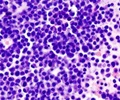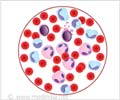Chronic lymphocytic leukemia is incurable, but continues to be made more manageable with the advent of powerful new chemoimmunotherapy tools.
Mayo Clinic Cancer Center, working in collaboration with Ohio State University Comprehensive Cancer Center, presented evidence Sunday that a novel regimen of three chemotherapy drugs, pentostatin, cyclophosphamide and rituximab, resulted in significant clinical response in patients with previously untreated chronic lymphocytic leukemia (CLL). Lead researcher and Mayo Clinic hematologist Neil E. Kay, M.D., presented these findings at the 2006 American Society of Hematology Annual Meeting in Orlando.
“Chronic lymphocytic leukemia is incurable, but continues to be made more manageable with the advent of powerful new chemoimmunotherapy tools,” says Dr. Kay. “We and our collaborators at Ohio State University, in particular Dr. Michael Grever, have done previous research on pentostatin that led us to believe there would be success with this regimen, and are pleased with the results.”Regimens using rituximab are common for CLL patients, says Dr. Kay, and his team decided to build upon that knowledge and their understanding of the highly potent chemotherapeutic antibiotic pentostatin to try to develop an even better treatment option. The investigators initiated a trial of three weeks (one cycle) of combined chemotherapy drugs pentostatin (P), cyclophosphamide (C) and rituximab (R) repeated in six cycles for 64 symptomatic but previously untreated patients. Patients in the study also received one year of prophylactic sulfamethoxazole-trimethoprim (anti-infection drug) and acyclovir (antiviral drug) along with the PCR treatment.
The researchers reviewed study participants’ prognostic status and divided the patients into risk categories at the beginning of the study, using a number of different prognostic evaluation tools to describe them, including the Rai stages (clinical levels of disease progression), CD38 and ZAP-70 (overexpressed proteins found in CLL cells), IgVH (mutational status of the immunoglobulin gene occurring in CLL patients), and FISH panel assessments (fluorescent probes on the chromosomes to determine common recurring genetic mutations in CLL). The majority of the patients were in high-risk categories; they had significant disease progression and/or a high expectation of rapid advancement of disease.
Following treatment, Dr. Kay’s team found that 91 percent of the patients experienced positive clinical responses (experienced improvement in their condition) to the treatment based on the National Cancer Institute’s Working Group criteria for responses. Forty-one percent achieved complete response, 22 percent experienced nodular partial response and 28 percent partial response, with the average patient’s disease currently estimated to being in response for 32.6 months. The researchers also found that bone marrow suppression and/or infections were minimal.
The prognostic variables that normally indicate likelihood of poor response to treatment appeared to be negated by the treatment --only one genetic defect (deletion of the p arm of chromosome 17) was found to prevent complete response or nodular partial response; the other risk factors did not diminish treatment effectiveness. Also, the researchers found that the regimen was equally effective in young and elderly (over age 70) patients.
“We are very pleased with the results of this study,” says Dr. Kay. “This is a new, viable option for high-risk patients who might not have had much hope before, and it’s especially exciting that it works for patients of all age groups.”
Source-Newswise
SRM








